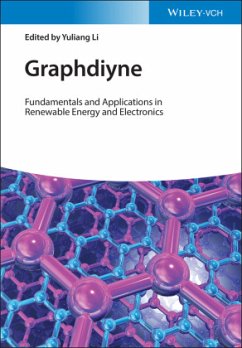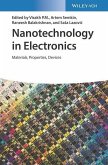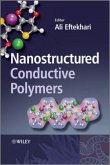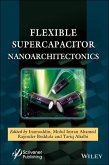Graphdiyne
Fundamentals and Applications in Renewable Energy and Electronics
Herausgegeben:Li, Yuliang
Graphdiyne
Fundamentals and Applications in Renewable Energy and Electronics
Herausgegeben:Li, Yuliang
- Gebundenes Buch
- Merkliste
- Auf die Merkliste
- Bewerten Bewerten
- Teilen
- Produkt teilen
- Produkterinnerung
- Produkterinnerung
Delivers a practical and insightful compilation of theoretical and experimental developments in the study of graphdiyne.
Andere Kunden interessierten sich auch für
![Amorphous Nanomaterials Amorphous Nanomaterials]() Lin GuoAmorphous Nanomaterials147,99 €
Lin GuoAmorphous Nanomaterials147,99 €![Nanotechnology in Electronics Nanotechnology in Electronics]() Nanotechnology in Electronics159,00 €
Nanotechnology in Electronics159,00 €![Metal Oxide Nanoparticles, 2 Volume Set Metal Oxide Nanoparticles, 2 Volume Set]() Metal Oxide Nanoparticles, 2 Volume Set443,99 €
Metal Oxide Nanoparticles, 2 Volume Set443,99 €![One-Dimensional Nanostructures One-Dimensional Nanostructures]() Tianyou ZhaiOne-Dimensional Nanostructures176,99 €
Tianyou ZhaiOne-Dimensional Nanostructures176,99 €![Nanostructured Conductive Polymers Nanostructured Conductive Polymers]() Nanostructured Conductive Polymers302,99 €
Nanostructured Conductive Polymers302,99 €![Flexible Supercapacitor Nanoarchitectonics Flexible Supercapacitor Nanoarchitectonics]() Flexible Supercapacitor Nanoarchitectonics257,99 €
Flexible Supercapacitor Nanoarchitectonics257,99 €![Nanostructured Multiferroics Nanostructured Multiferroics]() Nanostructured Multiferroics104,99 €
Nanostructured Multiferroics104,99 €-
-
-
Delivers a practical and insightful compilation of theoretical and experimental developments in the study of graphdiyne.
Hinweis: Dieser Artikel kann nur an eine deutsche Lieferadresse ausgeliefert werden.
Hinweis: Dieser Artikel kann nur an eine deutsche Lieferadresse ausgeliefert werden.
Produktdetails
- Produktdetails
- Verlag: Wiley-VCH
- Artikelnr. des Verlages: 1134787 000
- 1. Auflage
- Seitenzahl: 400
- Erscheinungstermin: 3. November 2021
- Englisch
- Abmessung: 23mm x 175mm x 250mm
- Gewicht: 900g
- ISBN-13: 9783527347872
- Artikelnr.: 61135106
- Herstellerkennzeichnung Die Herstellerinformationen sind derzeit nicht verfügbar.
- Verlag: Wiley-VCH
- Artikelnr. des Verlages: 1134787 000
- 1. Auflage
- Seitenzahl: 400
- Erscheinungstermin: 3. November 2021
- Englisch
- Abmessung: 23mm x 175mm x 250mm
- Gewicht: 900g
- ISBN-13: 9783527347872
- Artikelnr.: 61135106
- Herstellerkennzeichnung Die Herstellerinformationen sind derzeit nicht verfügbar.
Yuliang Li is Professor at the Institute of Chemistry, Chinese Academy of Sciences. He is the Academician of the Chinese Academy of Sciences. He worked as a visiting scholar and visiting professor in the Lab of Organic Chemistry at University of Amsterdam in Netherlands, the Radiation Lab at University of Notre Dame and Georgia Institute of Technology in USA, and Department of Chemistry at The University of Hong Kong. He has published more than 600 peer-reviewed scientific articles and invited reviews. He is the recipient of numerous awards including the Second-Class of National Natural Science Award of China (2014, 2002 and 2005), the Second-Class Award of Natural Science of Chinese Academy of Sciences (1999), the First-Class Award of Natural Science of Beijing (2014 and 2004), and The Prize for Scientific and Technological Progress of Ho Leung Ho Lee Foundation (2017).
1. Introduction
1.1 The Development of Carbon Materials
1.2 Models and Nomenclature
1.3 Brief Introduction of Graphdiyne
2. Basic Structure and Band Gap Engineering: Theoretical Study of GDYs
2.1 Structures
2.1.1 Theoretical Prediction and Classification
2.1.2 Geometric Structures of GDYs
2.2 Electronic Structures
2.2.1 Dirac Cones in a-,ß-, and 6,6,12-Graphynes
2.2.2 Semiconductor Properties of ¿-Graphynes
2.2.3 Electronic Structures Comparison of GDYs
2.2.4 Structure and Size Based Electronic Properties
2.3 Mechanical Properties
2.3.1 Mechanical Properties of GDYs
2.3.2 Mechanical Properties of ¿-Graphyne
2.3.3 Mechanical Properties of ¿-Graphdiyne
2.3.4 Mechanical properties of ¿-graphynes family
2.4 Layers Structure of Bulk GDYs
2.4.1 Stacking Modes for Bilayer a-Graphyne
2.4.2 Stacking modes for bilayer ¿-graphyne
2.4.3 Stacking Modes for Bilayer ¿-Graphdiyne
2.4.4 Identification on the Stacking Structures of GDY
2.5 Band Gap Engineering of GDYs
2.5.1 Influences of Nonmetal Doping
2.5.2 Influences of Chemical Modification and Functionalization
2.5.3 Tunable Band Gap under Strain
2.5.4 Graphyne Nanoribbons under Strain or Electric Field
3. GDY Synthesis and Characterization
3.1 Synthesis
3.1.1 Basic Chemistry
3.1.2 Synthesis of GDY Related Molecular Fragments
3.1.3 Cu-Surface-Mediated Synthesis
3.1.4 Template Synthesis
3.1.5 Interfacial Synthesis
3.1.6 Vapour-liquid-solid (VLS) Growth
3.1.7 Chemical Vapor Deposition (CVD) Growth
3.1.8 Explosion Approach
3.2 Characterization
3.2.1 Raman spectroscopy
3.2.2 X-ray photoelectron spectroscopy (XPS)
3.2.3 X-ray absorption spectroscopy (XAS)
3.2.4 Microscope Technology
3.2.5 X-ray Diffraction (XRD) Technique
3.2.6 Others
3.3 Summary
4 Functionalization of GDYs
4.1 Heteroatom Doping
4.1.1 Nitrogen and Phosphor Doping
4.1.2 Halogen Doping
4.1.3 Sulphur, Boron, Hydrogen and Other Non-Mental Heteroatoms
4.1.4 Dual Heteroatom Doping
4.2 Metal Decoration
4.2.1 Metal Atomic Decoration
4.2.2 Metallic Compounds
4.3 Absorption of Guest Molecules
5 Graphdiyne-Based Materials in Catalytic Applications
5.1. Graphdiyne-based zero-valent metal atomic catalysts
5.1.1 Synthetic strategy for GDY-based ACs
5.1.2 Adsorption Geometry and Electronic Structures of GDY-based ACs
5.1.3 Morphology and valence states of GDY-based ACs
5.1.4 Application of GDY-based ACs
5.2 GDY-based heterojunction catalysts
5.2.1 Hydrogen evolution reaction on GDY-based heteros
5.2.2 Oxygen evolution reaction on GDY-based heterojunction
5.2.3 Photo-/photoelectrocatalytic oxygen evolution reaction
5.2.4 Applied for overall water splitting
5.2.5 Applied for other catalysis
5.3 Graphdiyne Based Metal-free catalysts
5.3.1 Applied for water splitting
5.3.2 Applied for Oxygen Reduction Reactions
5.3.3 Applied for photocatalysis
6 Graphdiyne-Based Materials in Rechargeable Batteries Applications
6.1 Introduction
6.2 Lithium-Ion Battery Anodes
6.3 Graphdiyne Derivatives for LIB Anodes
6.4 Sodium Ion Battery Anodes
6.5 Electrochemical Interface
6.5.1 Protection for LIBs anodes
6.5.2 Protection for LIB cathodes
6.6 Lithium-Sulfur Battery
6.7 Lithium metal anodes
6.8 Supercapacitor Electrodes
6.9 Fuel cells
7. Graphdiyne-Based Materials in Solar Cells Applications
7.1 Introduction
7.2 Perovskite Solar Cells
7.2.1 Graphdiyne-Based Materials in Interfacial Layers
7.2.2 Graphdiyne-Based Materials in Active Layer
7.3 Organic Solar Cells
7.4 Others
7.4.1 Quantum Dots Solar Cells
7.4.2 Dye-sensitized solar cells
7.5 Future Perspectives
8 Graphdiyne: Electronics, thermoelectrics and magnetism applications
8.1 Electronic Devices
8.2 Optic Devices
8.3 Thermoelectric M
1.1 The Development of Carbon Materials
1.2 Models and Nomenclature
1.3 Brief Introduction of Graphdiyne
2. Basic Structure and Band Gap Engineering: Theoretical Study of GDYs
2.1 Structures
2.1.1 Theoretical Prediction and Classification
2.1.2 Geometric Structures of GDYs
2.2 Electronic Structures
2.2.1 Dirac Cones in a-,ß-, and 6,6,12-Graphynes
2.2.2 Semiconductor Properties of ¿-Graphynes
2.2.3 Electronic Structures Comparison of GDYs
2.2.4 Structure and Size Based Electronic Properties
2.3 Mechanical Properties
2.3.1 Mechanical Properties of GDYs
2.3.2 Mechanical Properties of ¿-Graphyne
2.3.3 Mechanical Properties of ¿-Graphdiyne
2.3.4 Mechanical properties of ¿-graphynes family
2.4 Layers Structure of Bulk GDYs
2.4.1 Stacking Modes for Bilayer a-Graphyne
2.4.2 Stacking modes for bilayer ¿-graphyne
2.4.3 Stacking Modes for Bilayer ¿-Graphdiyne
2.4.4 Identification on the Stacking Structures of GDY
2.5 Band Gap Engineering of GDYs
2.5.1 Influences of Nonmetal Doping
2.5.2 Influences of Chemical Modification and Functionalization
2.5.3 Tunable Band Gap under Strain
2.5.4 Graphyne Nanoribbons under Strain or Electric Field
3. GDY Synthesis and Characterization
3.1 Synthesis
3.1.1 Basic Chemistry
3.1.2 Synthesis of GDY Related Molecular Fragments
3.1.3 Cu-Surface-Mediated Synthesis
3.1.4 Template Synthesis
3.1.5 Interfacial Synthesis
3.1.6 Vapour-liquid-solid (VLS) Growth
3.1.7 Chemical Vapor Deposition (CVD) Growth
3.1.8 Explosion Approach
3.2 Characterization
3.2.1 Raman spectroscopy
3.2.2 X-ray photoelectron spectroscopy (XPS)
3.2.3 X-ray absorption spectroscopy (XAS)
3.2.4 Microscope Technology
3.2.5 X-ray Diffraction (XRD) Technique
3.2.6 Others
3.3 Summary
4 Functionalization of GDYs
4.1 Heteroatom Doping
4.1.1 Nitrogen and Phosphor Doping
4.1.2 Halogen Doping
4.1.3 Sulphur, Boron, Hydrogen and Other Non-Mental Heteroatoms
4.1.4 Dual Heteroatom Doping
4.2 Metal Decoration
4.2.1 Metal Atomic Decoration
4.2.2 Metallic Compounds
4.3 Absorption of Guest Molecules
5 Graphdiyne-Based Materials in Catalytic Applications
5.1. Graphdiyne-based zero-valent metal atomic catalysts
5.1.1 Synthetic strategy for GDY-based ACs
5.1.2 Adsorption Geometry and Electronic Structures of GDY-based ACs
5.1.3 Morphology and valence states of GDY-based ACs
5.1.4 Application of GDY-based ACs
5.2 GDY-based heterojunction catalysts
5.2.1 Hydrogen evolution reaction on GDY-based heteros
5.2.2 Oxygen evolution reaction on GDY-based heterojunction
5.2.3 Photo-/photoelectrocatalytic oxygen evolution reaction
5.2.4 Applied for overall water splitting
5.2.5 Applied for other catalysis
5.3 Graphdiyne Based Metal-free catalysts
5.3.1 Applied for water splitting
5.3.2 Applied for Oxygen Reduction Reactions
5.3.3 Applied for photocatalysis
6 Graphdiyne-Based Materials in Rechargeable Batteries Applications
6.1 Introduction
6.2 Lithium-Ion Battery Anodes
6.3 Graphdiyne Derivatives for LIB Anodes
6.4 Sodium Ion Battery Anodes
6.5 Electrochemical Interface
6.5.1 Protection for LIBs anodes
6.5.2 Protection for LIB cathodes
6.6 Lithium-Sulfur Battery
6.7 Lithium metal anodes
6.8 Supercapacitor Electrodes
6.9 Fuel cells
7. Graphdiyne-Based Materials in Solar Cells Applications
7.1 Introduction
7.2 Perovskite Solar Cells
7.2.1 Graphdiyne-Based Materials in Interfacial Layers
7.2.2 Graphdiyne-Based Materials in Active Layer
7.3 Organic Solar Cells
7.4 Others
7.4.1 Quantum Dots Solar Cells
7.4.2 Dye-sensitized solar cells
7.5 Future Perspectives
8 Graphdiyne: Electronics, thermoelectrics and magnetism applications
8.1 Electronic Devices
8.2 Optic Devices
8.3 Thermoelectric M
1. Introduction
1.1 The Development of Carbon Materials
1.2 Models and Nomenclature
1.3 Brief Introduction of Graphdiyne
2. Basic Structure and Band Gap Engineering: Theoretical Study of GDYs
2.1 Structures
2.1.1 Theoretical Prediction and Classification
2.1.2 Geometric Structures of GDYs
2.2 Electronic Structures
2.2.1 Dirac Cones in a-,ß-, and 6,6,12-Graphynes
2.2.2 Semiconductor Properties of ¿-Graphynes
2.2.3 Electronic Structures Comparison of GDYs
2.2.4 Structure and Size Based Electronic Properties
2.3 Mechanical Properties
2.3.1 Mechanical Properties of GDYs
2.3.2 Mechanical Properties of ¿-Graphyne
2.3.3 Mechanical Properties of ¿-Graphdiyne
2.3.4 Mechanical properties of ¿-graphynes family
2.4 Layers Structure of Bulk GDYs
2.4.1 Stacking Modes for Bilayer a-Graphyne
2.4.2 Stacking modes for bilayer ¿-graphyne
2.4.3 Stacking Modes for Bilayer ¿-Graphdiyne
2.4.4 Identification on the Stacking Structures of GDY
2.5 Band Gap Engineering of GDYs
2.5.1 Influences of Nonmetal Doping
2.5.2 Influences of Chemical Modification and Functionalization
2.5.3 Tunable Band Gap under Strain
2.5.4 Graphyne Nanoribbons under Strain or Electric Field
3. GDY Synthesis and Characterization
3.1 Synthesis
3.1.1 Basic Chemistry
3.1.2 Synthesis of GDY Related Molecular Fragments
3.1.3 Cu-Surface-Mediated Synthesis
3.1.4 Template Synthesis
3.1.5 Interfacial Synthesis
3.1.6 Vapour-liquid-solid (VLS) Growth
3.1.7 Chemical Vapor Deposition (CVD) Growth
3.1.8 Explosion Approach
3.2 Characterization
3.2.1 Raman spectroscopy
3.2.2 X-ray photoelectron spectroscopy (XPS)
3.2.3 X-ray absorption spectroscopy (XAS)
3.2.4 Microscope Technology
3.2.5 X-ray Diffraction (XRD) Technique
3.2.6 Others
3.3 Summary
4 Functionalization of GDYs
4.1 Heteroatom Doping
4.1.1 Nitrogen and Phosphor Doping
4.1.2 Halogen Doping
4.1.3 Sulphur, Boron, Hydrogen and Other Non-Mental Heteroatoms
4.1.4 Dual Heteroatom Doping
4.2 Metal Decoration
4.2.1 Metal Atomic Decoration
4.2.2 Metallic Compounds
4.3 Absorption of Guest Molecules
5 Graphdiyne-Based Materials in Catalytic Applications
5.1. Graphdiyne-based zero-valent metal atomic catalysts
5.1.1 Synthetic strategy for GDY-based ACs
5.1.2 Adsorption Geometry and Electronic Structures of GDY-based ACs
5.1.3 Morphology and valence states of GDY-based ACs
5.1.4 Application of GDY-based ACs
5.2 GDY-based heterojunction catalysts
5.2.1 Hydrogen evolution reaction on GDY-based heteros
5.2.2 Oxygen evolution reaction on GDY-based heterojunction
5.2.3 Photo-/photoelectrocatalytic oxygen evolution reaction
5.2.4 Applied for overall water splitting
5.2.5 Applied for other catalysis
5.3 Graphdiyne Based Metal-free catalysts
5.3.1 Applied for water splitting
5.3.2 Applied for Oxygen Reduction Reactions
5.3.3 Applied for photocatalysis
6 Graphdiyne-Based Materials in Rechargeable Batteries Applications
6.1 Introduction
6.2 Lithium-Ion Battery Anodes
6.3 Graphdiyne Derivatives for LIB Anodes
6.4 Sodium Ion Battery Anodes
6.5 Electrochemical Interface
6.5.1 Protection for LIBs anodes
6.5.2 Protection for LIB cathodes
6.6 Lithium-Sulfur Battery
6.7 Lithium metal anodes
6.8 Supercapacitor Electrodes
6.9 Fuel cells
7. Graphdiyne-Based Materials in Solar Cells Applications
7.1 Introduction
7.2 Perovskite Solar Cells
7.2.1 Graphdiyne-Based Materials in Interfacial Layers
7.2.2 Graphdiyne-Based Materials in Active Layer
7.3 Organic Solar Cells
7.4 Others
7.4.1 Quantum Dots Solar Cells
7.4.2 Dye-sensitized solar cells
7.5 Future Perspectives
8 Graphdiyne: Electronics, thermoelectrics and magnetism applications
8.1 Electronic Devices
8.2 Optic Devices
8.3 Thermoelectric M
1.1 The Development of Carbon Materials
1.2 Models and Nomenclature
1.3 Brief Introduction of Graphdiyne
2. Basic Structure and Band Gap Engineering: Theoretical Study of GDYs
2.1 Structures
2.1.1 Theoretical Prediction and Classification
2.1.2 Geometric Structures of GDYs
2.2 Electronic Structures
2.2.1 Dirac Cones in a-,ß-, and 6,6,12-Graphynes
2.2.2 Semiconductor Properties of ¿-Graphynes
2.2.3 Electronic Structures Comparison of GDYs
2.2.4 Structure and Size Based Electronic Properties
2.3 Mechanical Properties
2.3.1 Mechanical Properties of GDYs
2.3.2 Mechanical Properties of ¿-Graphyne
2.3.3 Mechanical Properties of ¿-Graphdiyne
2.3.4 Mechanical properties of ¿-graphynes family
2.4 Layers Structure of Bulk GDYs
2.4.1 Stacking Modes for Bilayer a-Graphyne
2.4.2 Stacking modes for bilayer ¿-graphyne
2.4.3 Stacking Modes for Bilayer ¿-Graphdiyne
2.4.4 Identification on the Stacking Structures of GDY
2.5 Band Gap Engineering of GDYs
2.5.1 Influences of Nonmetal Doping
2.5.2 Influences of Chemical Modification and Functionalization
2.5.3 Tunable Band Gap under Strain
2.5.4 Graphyne Nanoribbons under Strain or Electric Field
3. GDY Synthesis and Characterization
3.1 Synthesis
3.1.1 Basic Chemistry
3.1.2 Synthesis of GDY Related Molecular Fragments
3.1.3 Cu-Surface-Mediated Synthesis
3.1.4 Template Synthesis
3.1.5 Interfacial Synthesis
3.1.6 Vapour-liquid-solid (VLS) Growth
3.1.7 Chemical Vapor Deposition (CVD) Growth
3.1.8 Explosion Approach
3.2 Characterization
3.2.1 Raman spectroscopy
3.2.2 X-ray photoelectron spectroscopy (XPS)
3.2.3 X-ray absorption spectroscopy (XAS)
3.2.4 Microscope Technology
3.2.5 X-ray Diffraction (XRD) Technique
3.2.6 Others
3.3 Summary
4 Functionalization of GDYs
4.1 Heteroatom Doping
4.1.1 Nitrogen and Phosphor Doping
4.1.2 Halogen Doping
4.1.3 Sulphur, Boron, Hydrogen and Other Non-Mental Heteroatoms
4.1.4 Dual Heteroatom Doping
4.2 Metal Decoration
4.2.1 Metal Atomic Decoration
4.2.2 Metallic Compounds
4.3 Absorption of Guest Molecules
5 Graphdiyne-Based Materials in Catalytic Applications
5.1. Graphdiyne-based zero-valent metal atomic catalysts
5.1.1 Synthetic strategy for GDY-based ACs
5.1.2 Adsorption Geometry and Electronic Structures of GDY-based ACs
5.1.3 Morphology and valence states of GDY-based ACs
5.1.4 Application of GDY-based ACs
5.2 GDY-based heterojunction catalysts
5.2.1 Hydrogen evolution reaction on GDY-based heteros
5.2.2 Oxygen evolution reaction on GDY-based heterojunction
5.2.3 Photo-/photoelectrocatalytic oxygen evolution reaction
5.2.4 Applied for overall water splitting
5.2.5 Applied for other catalysis
5.3 Graphdiyne Based Metal-free catalysts
5.3.1 Applied for water splitting
5.3.2 Applied for Oxygen Reduction Reactions
5.3.3 Applied for photocatalysis
6 Graphdiyne-Based Materials in Rechargeable Batteries Applications
6.1 Introduction
6.2 Lithium-Ion Battery Anodes
6.3 Graphdiyne Derivatives for LIB Anodes
6.4 Sodium Ion Battery Anodes
6.5 Electrochemical Interface
6.5.1 Protection for LIBs anodes
6.5.2 Protection for LIB cathodes
6.6 Lithium-Sulfur Battery
6.7 Lithium metal anodes
6.8 Supercapacitor Electrodes
6.9 Fuel cells
7. Graphdiyne-Based Materials in Solar Cells Applications
7.1 Introduction
7.2 Perovskite Solar Cells
7.2.1 Graphdiyne-Based Materials in Interfacial Layers
7.2.2 Graphdiyne-Based Materials in Active Layer
7.3 Organic Solar Cells
7.4 Others
7.4.1 Quantum Dots Solar Cells
7.4.2 Dye-sensitized solar cells
7.5 Future Perspectives
8 Graphdiyne: Electronics, thermoelectrics and magnetism applications
8.1 Electronic Devices
8.2 Optic Devices
8.3 Thermoelectric M








